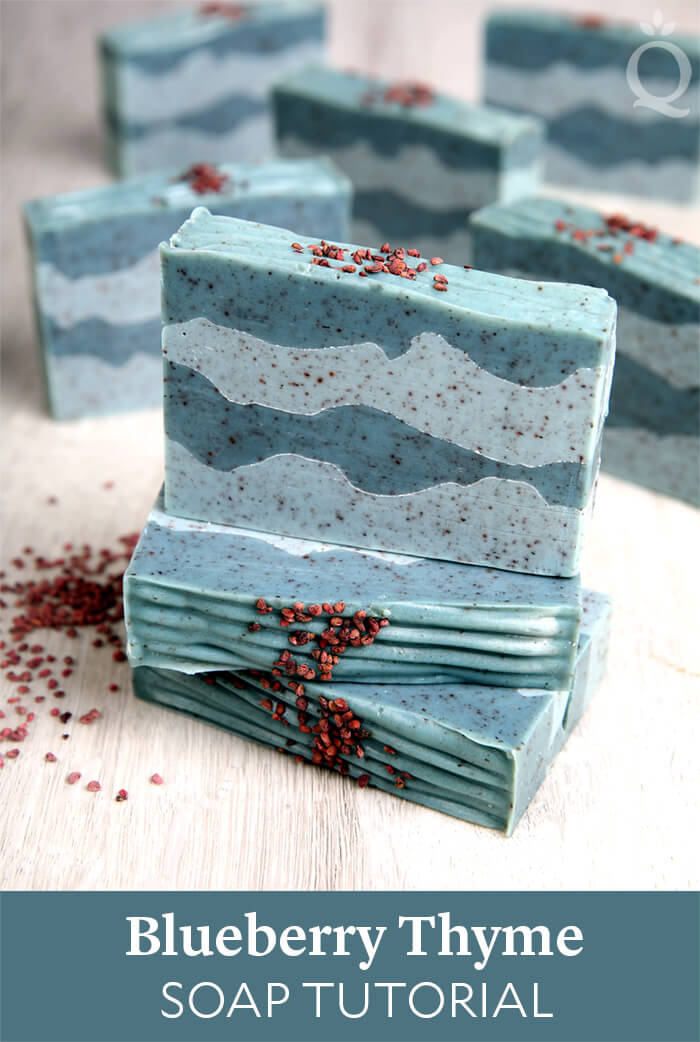
New Blueberry Thyme Fragrance Oil – part of the Farmers Market Collection – is inspired by artisan cocktails that blend sweet and savory elements. It has notes of lemon, Spanish rosemary, and vanilla. Those notes inspired the design in this cold process recipe.
A combination of red sandalwood powder and Caribbean Blue Mica create light and dark navy shades. Between each layer there's a titanium dioxide pencil line to add interest. Finally, a fork is used to create texture on top and it's finished with blackberry seeds.
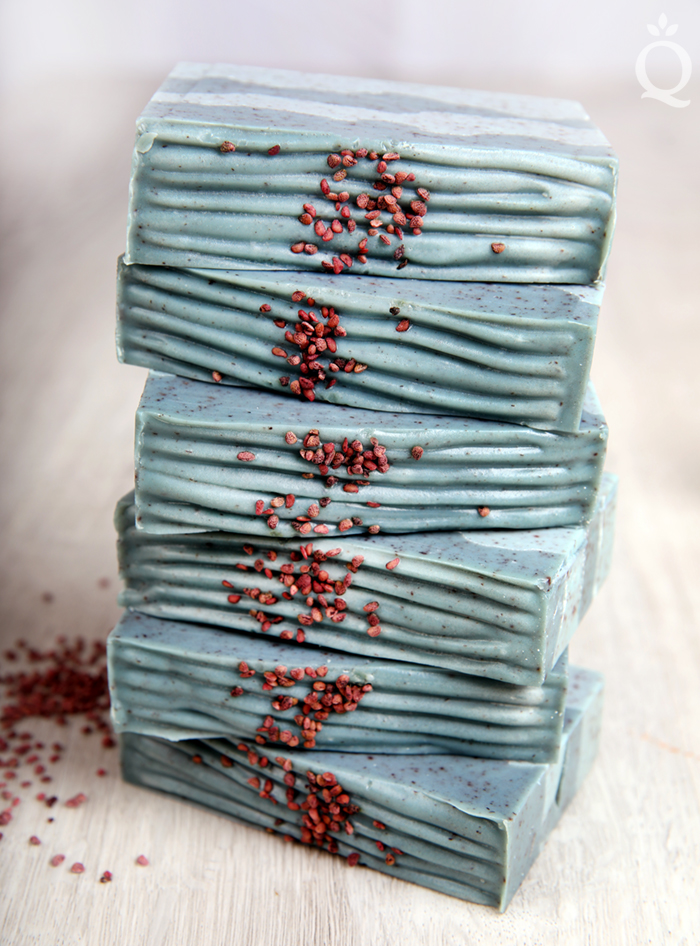 Blueberry Thyme Fragrance Oil discolors yellow, and then fades to a light tan over time. You’ll notice the soap in these photos looks slightly green, while the final bars look more blue. This is due to the yellow discoloration fading. This recipe uses a low fragrance oil usage rate to keep that discoloration to a minimum. If you use a stronger usage rate, keep in mind it may affect the color.
Blueberry Thyme Fragrance Oil discolors yellow, and then fades to a light tan over time. You’ll notice the soap in these photos looks slightly green, while the final bars look more blue. This is due to the yellow discoloration fading. This recipe uses a low fragrance oil usage rate to keep that discoloration to a minimum. If you use a stronger usage rate, keep in mind it may affect the color.
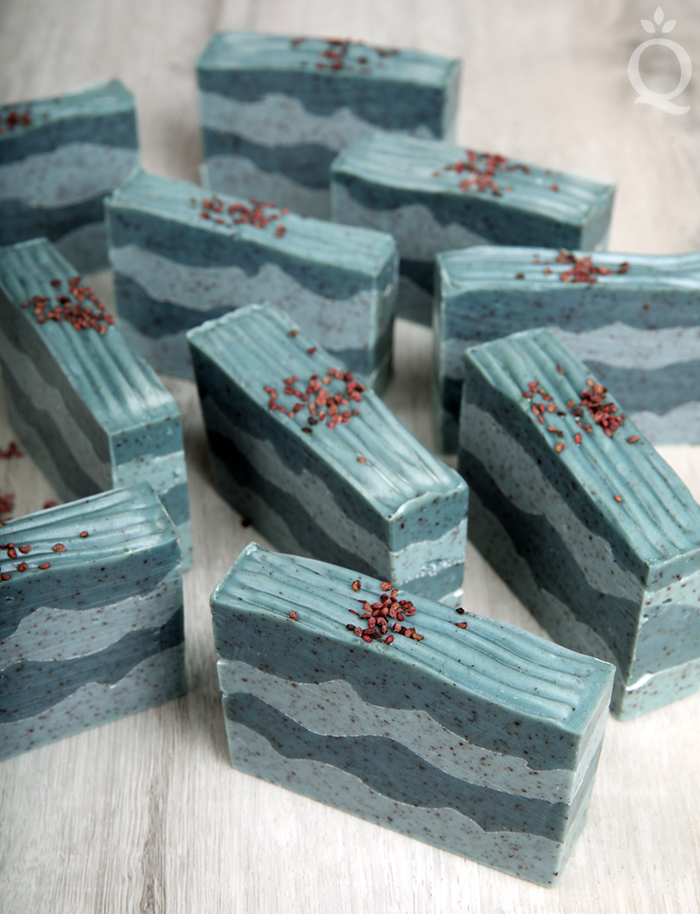
If you've never made cold process soap before, stop here. We highly recommend checking out our FREE four part SoapQueen.tv series on cold process soapmaking, especially the episode on lye safety. And if you'd rather do some reading, Bramble Berry carries a wide range of books on the topic, including Pure Soapmaking. You can also check out the digital downloads for that instant gratification factor.
FRAGRANCE PREP: Measure 1.5 ounces of Blueberry Thyme Fragrance Oil into a small glass container and set aside.
COLORANT PREP: Disperse 1 teaspoon of the titanium dioxide into 1 tablespoon of sunflower or sweet almond oil (or any other liquid oil). Use a mini mixer to get rid of any clumps. In a separate container, mix 1 teaspoon of Caribbean Blue Mica into 1 tablespoon lightweight liquid oil. Use a mini mixer to get rid of any clumps. Finally, mix 1/2 teaspoon of black oxide with 1/2 tablespoon lightweight liquid oil. Have 2 teaspoons of red sandalwood powder nearby.
Optional: To ensure the titanium dioxide blends smoothly into the soap batter, we recommend micronizing it before dispersing it in oil. Use a coffee grinder to break up any clumps of color and prevent streaks of white from showing in the final soap. We like to use a coffee grinder that has a removable stainless steel mixing area for easy cleaning.
SAFETY FIRST: Suit up for safe handling practices. That means goggles, gloves, and long sleeves. Make sure kids, pets, other distractions, and tripping hazards are out of the house or don't have access to your soaping space. Always soap in a well-ventilated area.
ONE: Slowly and carefully add 4.9 ounces of lye to 10.4 ounces of distilled water and gently stir until the lye has fully dissolved and the liquid is clear. Set aside to cool. If you'd like a harder bar of soap that releases faster from the mold, you can add sodium lactate to the cooled lye water. Use 1 teaspoon of sodium lactate per pound of oils in the recipe. For this recipe, you'd add 2 teaspoons sodium lactate.
TWO: Melt and combine 1 ounce of castor oil, 8.7 ounces of coconut oil, 9.4 ounces of olive oil, 8.7 ounces of palm oil, 3.5 ounces of sunflower oil, and 3.5 ounces of raspberry seed oil (remember to fully melt then mix your entire container of palm oil before portioning). Add 2 teaspoons of red sandalwood powder directly into the oils. Use the stick blender to fully mix in and get rid of clumps.
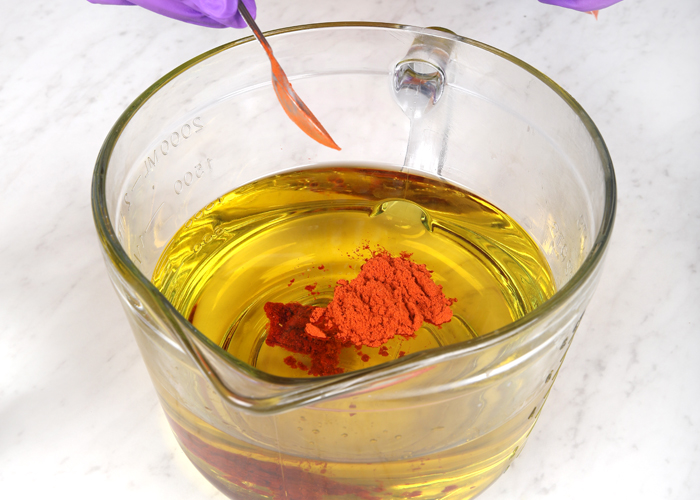
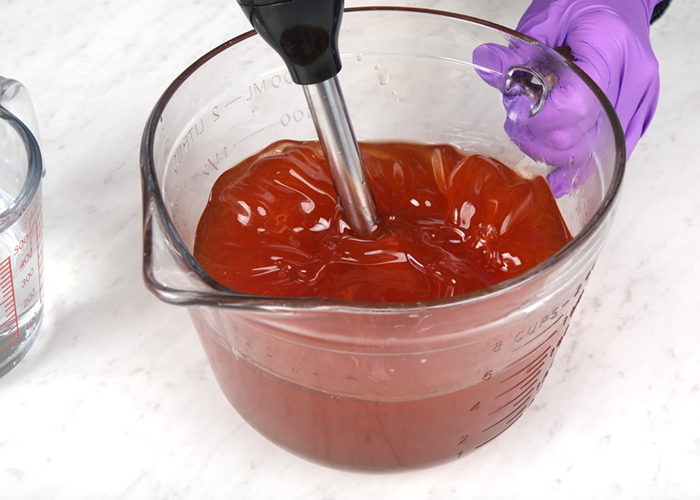 THREE: Once the lye water and the oils have cooled to 130 degrees F or below (and are ideally within 10 degrees of each other), add the lye water to the oils and stick blend the mixture to a thin trace.
THREE: Once the lye water and the oils have cooled to 130 degrees F or below (and are ideally within 10 degrees of each other), add the lye water to the oils and stick blend the mixture to a thin trace.
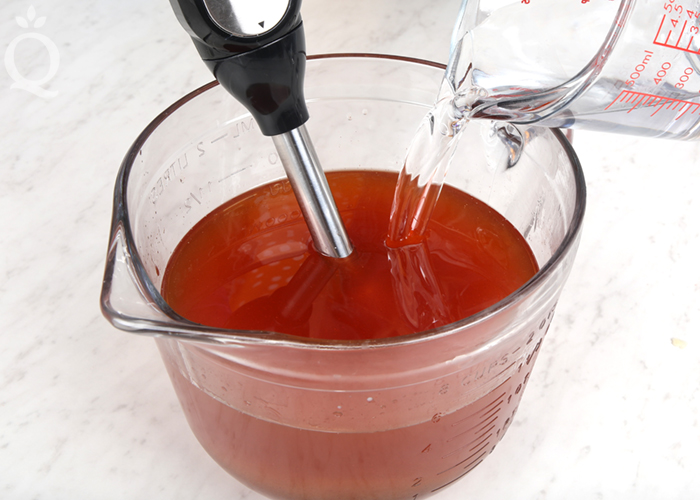 FOUR: Add the 1.5 ounces of Blueberry Thyme Fragrance Oil and all of the dispersed Caribbean Blue Mica into the entire batch of soap. Use a stick blender to mix them in.
FOUR: Add the 1.5 ounces of Blueberry Thyme Fragrance Oil and all of the dispersed Caribbean Blue Mica into the entire batch of soap. Use a stick blender to mix them in.
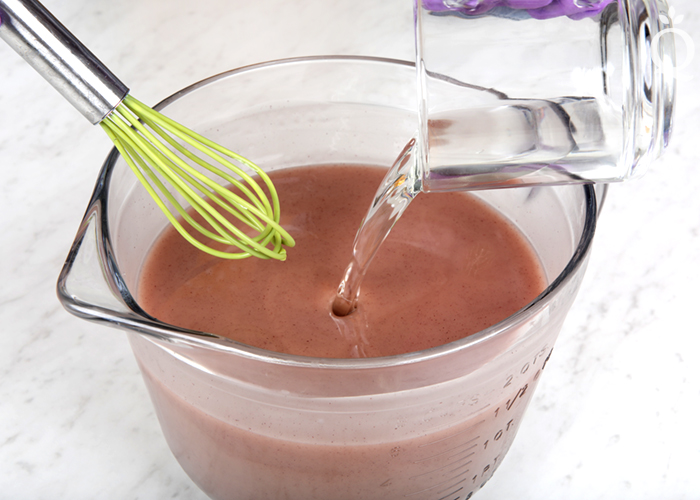 FIVE: Split the batch in half equally – each container will be about 750 mL. Add 1/2 teaspoon dispersed black oxide to one container and 1 tablespoon of dispersed titanium dioxide to the other.
FIVE: Split the batch in half equally – each container will be about 750 mL. Add 1/2 teaspoon dispersed black oxide to one container and 1 tablespoon of dispersed titanium dioxide to the other.
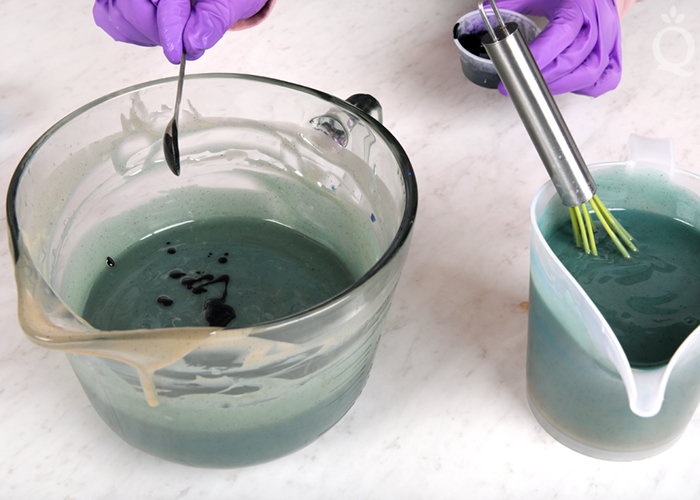 SIX: The soap batter needs to be a medium trace. If it’s still thin, pulse each container with the stick blender to thicken. It should be the texture of thick pudding.
SIX: The soap batter needs to be a medium trace. If it’s still thin, pulse each container with the stick blender to thicken. It should be the texture of thick pudding.
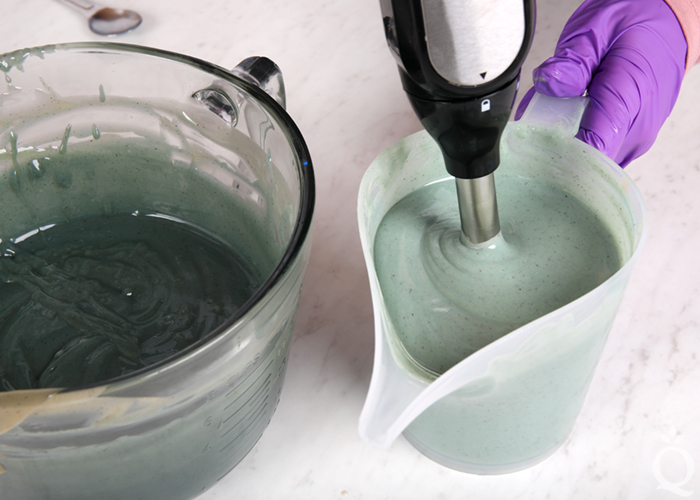 SEVEN: Pour half of the light blue batter into the mold and tap on the counter to level the soap. Use a spoon to create divots down the length of the mold. That gives the layers an interesting and rustic shape.
SEVEN: Pour half of the light blue batter into the mold and tap on the counter to level the soap. Use a spoon to create divots down the length of the mold. That gives the layers an interesting and rustic shape.
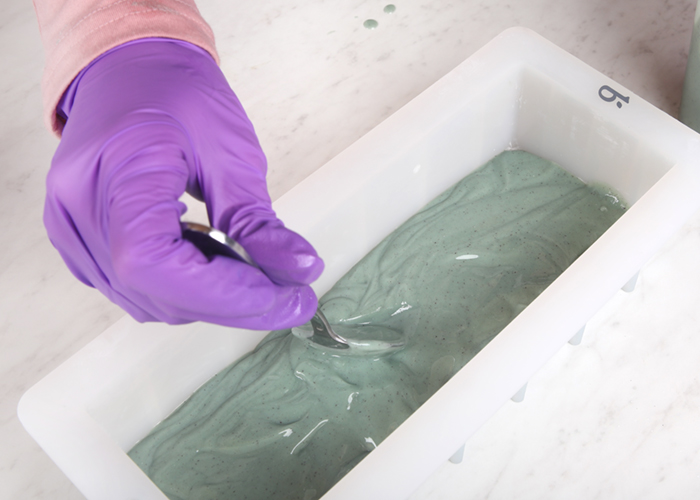 EIGHT: Add a few teaspoons of titanium dioxide to a Powder Duster or mesh strainer and sprinkle a fine layer across the soap. Be careful to use a small amount of titanium dioxide or the soap may separate when cut.
EIGHT: Add a few teaspoons of titanium dioxide to a Powder Duster or mesh strainer and sprinkle a fine layer across the soap. Be careful to use a small amount of titanium dioxide or the soap may separate when cut.
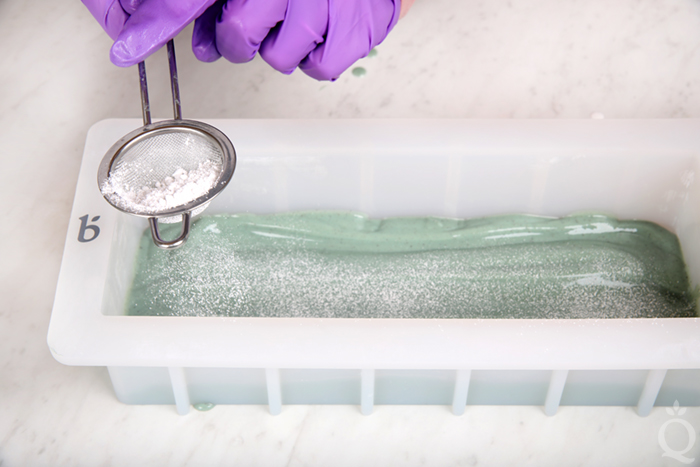 NINE: Use a spoon to plop half of the dark blue soap on top of the light blue layer in the mold. Firmly tap the mold on the counter to help settle the soap and get rid of bubbles. Use a spoon to create divots down the length of the soap.
NINE: Use a spoon to plop half of the dark blue soap on top of the light blue layer in the mold. Firmly tap the mold on the counter to help settle the soap and get rid of bubbles. Use a spoon to create divots down the length of the soap.
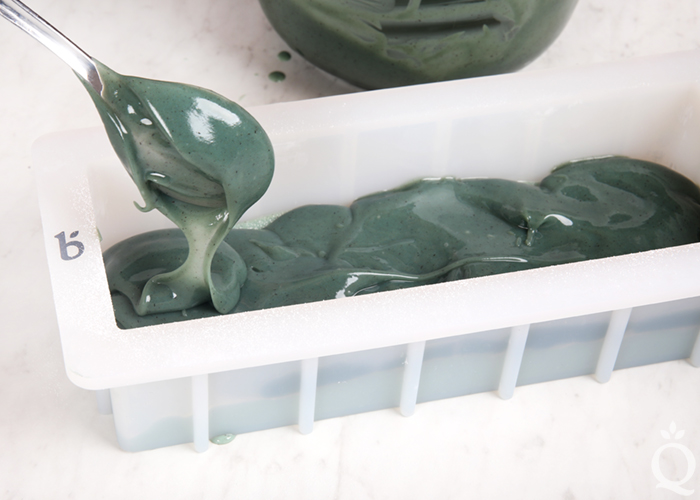 TEN: Dust another thin layer of titanium dioxide on top of the dark soap. Be careful to not make the layer too thick.
TEN: Dust another thin layer of titanium dioxide on top of the dark soap. Be careful to not make the layer too thick.
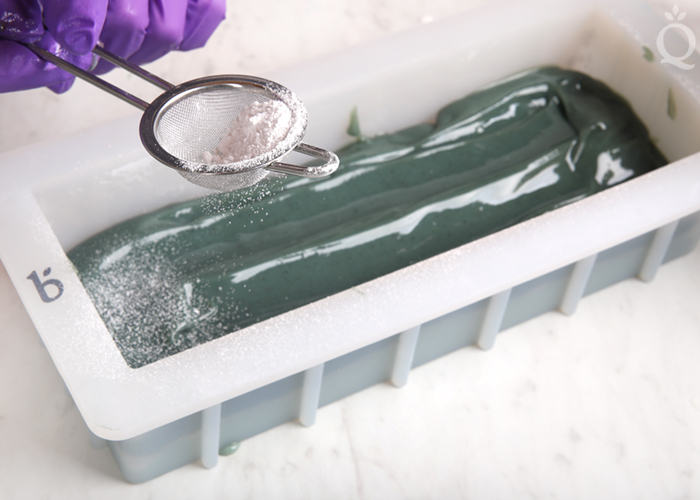 ELEVEN: Dollop the rest of the light blue soap into the mold, tap on the counter, use a spoon to create divots, and dust with a layer titanium dioxide.
ELEVEN: Dollop the rest of the light blue soap into the mold, tap on the counter, use a spoon to create divots, and dust with a layer titanium dioxide.
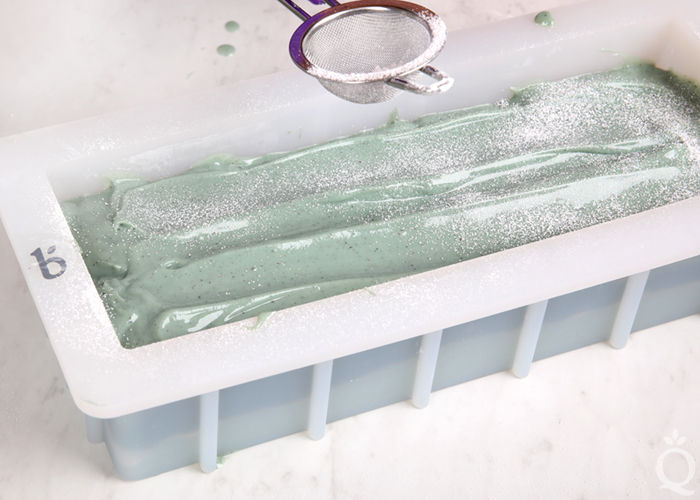 TWELVE: Use a spoon to gently dollop the remaining dark blue soap into the mold. Tap firmly on the counter to get rid of bubbles. Use a fork to create texture down the entire length of the mold.
TWELVE: Use a spoon to gently dollop the remaining dark blue soap into the mold. Tap firmly on the counter to get rid of bubbles. Use a fork to create texture down the entire length of the mold.
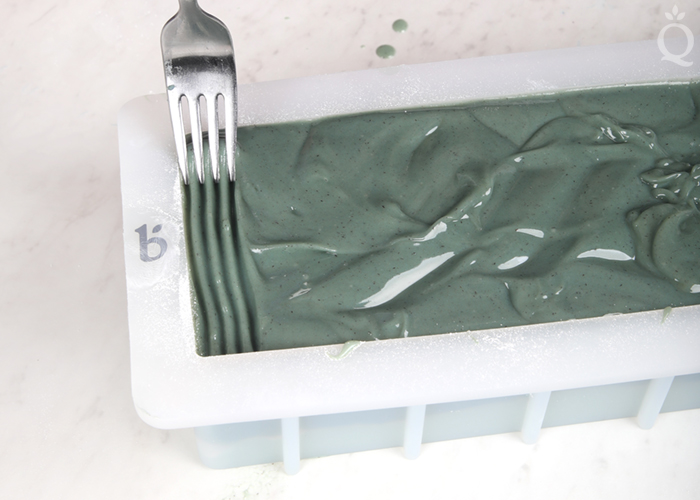 THIRTEEN: Sprinkle blackberry seeds in the center down the length of the mold. Spritz 99% isopropyl alcohol on the top of the soap to prevent soda ash.
THIRTEEN: Sprinkle blackberry seeds in the center down the length of the mold. Spritz 99% isopropyl alcohol on the top of the soap to prevent soda ash.
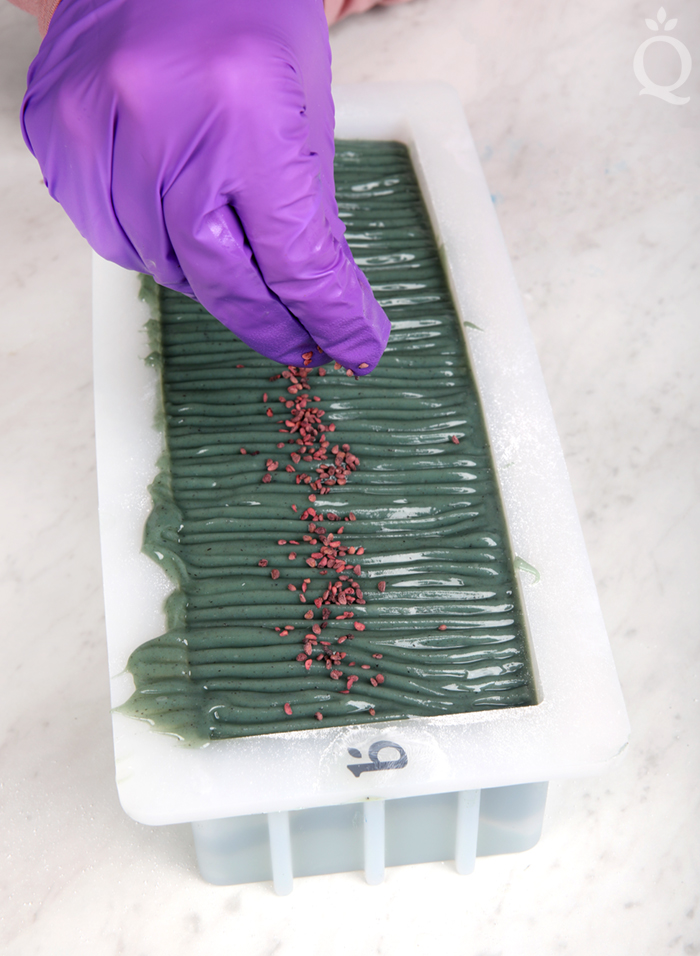 FOURTEEN: This soap benefits from being lightly insulated. You can place the soap in a drawer or other small space to stay warm. Allow the soap to stay in the mold for 2-3 days. Unmold and cut into bars.
FOURTEEN: This soap benefits from being lightly insulated. You can place the soap in a drawer or other small space to stay warm. Allow the soap to stay in the mold for 2-3 days. Unmold and cut into bars.
We recommend flipping and cutting the soap on its side to prevent the seeds from creating drag marks. That also prevents the titanium dioxide from smearing across the bars. If this happens (it happened to ours!), gently wiping the bars with 99% isopropyl alcohol and a tissue can help clean them up. The Soap Shaver also helps. Once cut, allow them to cure for 4-6 weeks. Enjoy.
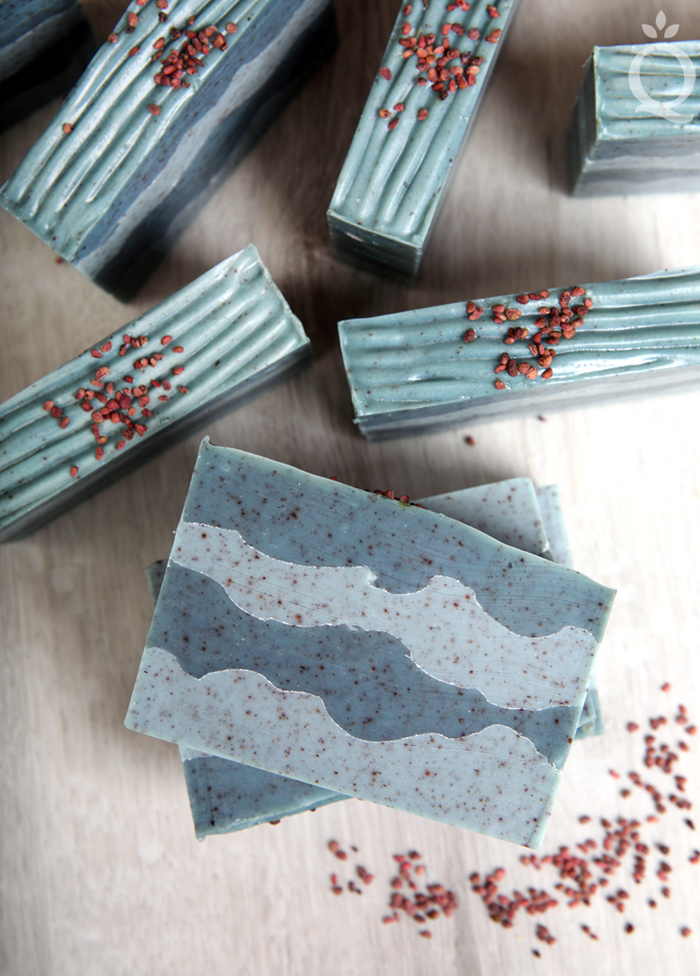
Blueberry Thyme Soap Tutorial
Author: Soap Queen
Recipe type: Cold Process Soap
- 10″ Silicone Loaf Mold
- 1 oz. Castor Oil (2.9%)
- 8.7 oz. Coconut Oil (25%)
- 9.4 oz. Olive Oil (27%)
- 8.7 oz. Palm Oil (25%)
- 3.5 oz. Raspberry Seed Oil (10.1%)
- 3.5 oz. Sunflower Oil (10.1%)
- 4.9 oz. Sodium Hydroxide Lye
- 10.4 oz. Distilled Water (10% water discount)
- 1.5 oz. Blueberry Thyme Fragrance Oil
- Red Sandalwood Powder
- Caribbean Blue Mica
- Titanium Dioxide
- Black Oxide
- Blackberry Seeds
- Slowly and carefully add 4.9 ounces of lye to 10.4 ounces of distilled water and gently stir until the lye has fully dissolved and the liquid is clear. Set aside to cool. If you'd like a harder bar of soap that releases faster from the mold, you can add sodium lactate to the cooled lye water. Use 1 teaspoon of sodium lactate per pound of oils in the recipe. For this recipe, you'd add 2 teaspoons sodium lactate.
- Melt and combine 1 ounce of castor oil, 8.7 ounces of coconut oil, 9.4 ounces of olive oil, 8.7 ounces of palm oil, 3.5 ounces of sunflower oil, and 3.5 ounces of raspberry seed oil (remember to fully melt then mix your entire container of palm oil before portioning). Add 2 teaspoons of red sandalwood powder directly into the oils. Use the stick blender to fully mix in and get rid of clumps.
- Once the lye water and the oils have cooled to 130 degrees F or below (and are ideally within 10 degrees of each other), add the lye water to the oils and stick blend the mixture to a thin trace.
- Add the 1.5 ounces of Blueberry Thyme Fragrance Oil and all of the dispersed Caribbean Blue Mica into the entire batch of soap. Use a stick blender to mix them in.
- Split the batch in half equally – each container will be about 750 mL. Add ½ teaspoon dispersed black oxide to one container and 1 tablespoon of dispersed titanium dioxide to the other.
- The soap batter needs to be a medium trace. If it's still thin, pulse each container with the stick blender to thicken. It should be the texture of thick pudding.
- Pour half of the light blue batter into the mold and tap on the counter to level the soap. Use a spoon to create divots down the length of the mold. That gives the layers an interesting and rustic shape.
- Add a few teaspoons of titanium dioxide to a Powder Duster or mesh strainer and sprinkle a fine layer across the soap. Be careful to use a small amount of titanium dioxide or the soap may separate when cut.
- Use a spoon to plop half of the dark blue soap on top of the light blue layer in the mold. Firmly tap the mold on the counter to help settle the soap and get rid of bubbles. Use a spoon to create divots down the length of the soap.
- Dust another thin layer of titanium dioxide on top of the dark soap. Be careful to not make the layer too thick.
- Dollop the rest of the light blue soap into the mold, tap on the counter, use a spoon to create divots, and dust with a layer titanium dioxide.
- Use a spoon to gently dollop the remaining dark blue soap into the mold. Tap firmly on the counter to get rid of bubbles. Use a fork to create texture down the entire length of the mold.
- Sprinkle blackberry seeds in the center down the length of the mold. Spritz 99% isopropyl alcohol on the top of the soap to prevent soda ash. This soap benefits from being lightly insulated. You can place the soap in a drawer or other small space to stay warm. Allow the soap to stay in the mold for 2-3 days. Unmold and cut into bars.
- We recommend flipping and cutting the soap on its side to prevent the seeds from creating drag marks. That also prevents the titanium dioxide from smearing across the bars. If this happens (it happened to ours!), gently wiping the bars with 99% isopropyl alcohol and a tissue can help clean them up. The Soap Shaver also helps. Once cut, allow them to cure for 4-6 weeks. Enjoy.
3.3.3077
The post Blueberry Thyme Soap Tutorial appeared first on Soap Queen.





 THREE: Once the lye water and the oils have cooled to 130 degrees F or below (and are ideally within 10 degrees of each other), add the lye water to the oils and stick blend the mixture to a thin trace.
THREE: Once the lye water and the oils have cooled to 130 degrees F or below (and are ideally within 10 degrees of each other), add the lye water to the oils and stick blend the mixture to a thin trace. FOUR: Add the 1.5 ounces of Blueberry Thyme Fragrance Oil and all of the dispersed Caribbean Blue Mica into the entire batch of soap. Use a stick blender to mix them in.
FOUR: Add the 1.5 ounces of Blueberry Thyme Fragrance Oil and all of the dispersed Caribbean Blue Mica into the entire batch of soap. Use a stick blender to mix them in. FIVE: Split the batch in half equally – each container will be about 750 mL. Add 1/2 teaspoon dispersed black oxide to one container and 1 tablespoon of dispersed titanium dioxide to the other.
FIVE: Split the batch in half equally – each container will be about 750 mL. Add 1/2 teaspoon dispersed black oxide to one container and 1 tablespoon of dispersed titanium dioxide to the other. SIX: The soap batter needs to be a medium trace. If it’s still thin, pulse each container with the stick blender to thicken. It should be the texture of thick pudding.
SIX: The soap batter needs to be a medium trace. If it’s still thin, pulse each container with the stick blender to thicken. It should be the texture of thick pudding. SEVEN: Pour half of the light blue batter into the mold and tap on the counter to level the soap. Use a spoon to create divots down the length of the mold. That gives the layers an interesting and rustic shape.
SEVEN: Pour half of the light blue batter into the mold and tap on the counter to level the soap. Use a spoon to create divots down the length of the mold. That gives the layers an interesting and rustic shape. EIGHT: Add a few teaspoons of titanium dioxide to a
EIGHT: Add a few teaspoons of titanium dioxide to a  NINE: Use a spoon to plop half of the dark blue soap on top of the light blue layer in the mold. Firmly tap the mold on the counter to help settle the soap and get rid of bubbles. Use a spoon to create divots down the length of the soap.
NINE: Use a spoon to plop half of the dark blue soap on top of the light blue layer in the mold. Firmly tap the mold on the counter to help settle the soap and get rid of bubbles. Use a spoon to create divots down the length of the soap. TEN: Dust another thin layer of titanium dioxide on top of the dark soap. Be careful to not make the layer too thick.
TEN: Dust another thin layer of titanium dioxide on top of the dark soap. Be careful to not make the layer too thick. ELEVEN: Dollop the rest of the light blue soap into the mold, tap on the counter, use a spoon to create divots, and dust with a layer titanium dioxide.
ELEVEN: Dollop the rest of the light blue soap into the mold, tap on the counter, use a spoon to create divots, and dust with a layer titanium dioxide. TWELVE: Use a spoon to gently dollop the remaining dark blue soap into the mold. Tap firmly on the counter to get rid of bubbles. Use a fork to create texture down the entire length of the mold.
TWELVE: Use a spoon to gently dollop the remaining dark blue soap into the mold. Tap firmly on the counter to get rid of bubbles. Use a fork to create texture down the entire length of the mold. THIRTEEN: Sprinkle blackberry seeds in the center down the length of the mold. Spritz
THIRTEEN: Sprinkle blackberry seeds in the center down the length of the mold. Spritz  FOURTEEN: This soap benefits from being
FOURTEEN: This soap benefits from being 
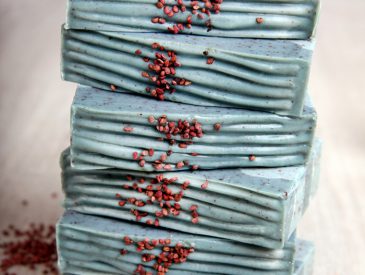
Keine Kommentare:
Kommentar veröffentlichen